I thought the Arbus Ring Lock from Speedy Locksmith would be just the thing for my Surly Long Haul Trucker. It’s a lock that bolts to the seat stays. When you want to secure your bike, you turn a key, pull down on a lever and a metal ring slides out to lock the rear wheel through the spokes.
The only catch is that you have to be smarter than the lock to install it.
They are popular in Europe
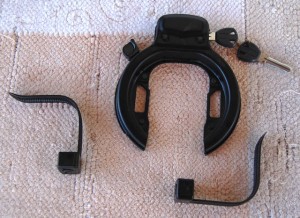 Son Matt said he saw lots of them when he was evaluating software in Denmark.
Son Matt said he saw lots of them when he was evaluating software in Denmark.
They’re not intended for high-theft areas or for overnight security, but it seemed like just the thing for when you run into the store for a couple of minutes.
I was placing an order with Velo Orange when I saw a listing for the Arbus ring lock. I figured $25 was a small enough investment to risk. If it worked, cool. Either way I’d get a review out of it.
Only four parts
Installation should be a snap. There are only four parts: the lock, two plastic straps and two keys (OK, that’s five parts if you count the keys separately).
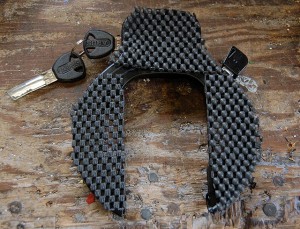 I was so confident that it would go smoothly that I used Marine Goop to apply some rubber backing to the lock so it wouldn’t scratch the paint on my LHT and I cut some pieces of innertube for the other places it might rub.
I was so confident that it would go smoothly that I used Marine Goop to apply some rubber backing to the lock so it wouldn’t scratch the paint on my LHT and I cut some pieces of innertube for the other places it might rub.
I let the Goop dry overnight and then put the bike up on my Park Tool PCS-10 Repair Rack to attach the lock.
It should lock the wheel through the spokes
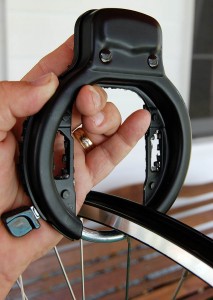 Before I got to the hard work, though, I pulled a spare rim off the Cycle Tree and checked out the theory.
Before I got to the hard work, though, I pulled a spare rim off the Cycle Tree and checked out the theory.
Yep, it makes sense. That bike ain’t going anywhere. I don’t think the bad guy could get up enough speed to damage your spokes, either.
I had a NoMo moment
I worked with a guy we nicknamed NoMo. At some point during every call to the Help Desk, he’d say, “I’m no moron. (Pronounced in his drawl as no mo-ron.)
Here’s a rule of thumb: if you have to go around telling folks that you ain’t a mo-ron, there’s a pretty good chance that you are one.
I started off placing all the innertube cushions where I thought they’d go and then I took the plastic strapping that resembles a pipe clamp and started screwing.
First off, even though the groove for the screw driver was fairly deep, it wasn’t long before I had buggered it up pretty good, particularly since I tried about four different variations of how to put it on.
Wrestling that stiff piece of plastic was NOT a task someone should attempt on the Lord’s Day. I was careful to pad the LHT against scratches, but I’m afraid that I may have scorched the paint in a couple of places.
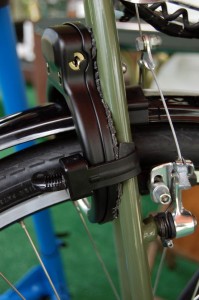 Here’s kinda what it should look like
Here’s kinda what it should look like
But, not exactly. The strapping shouldn’t go around the outside of the lock (I don’t think). But, it’ll give you a r0ugh idea of what it would look like.
No matter what I did, I couldn’t get the thing to look or feel right. The more I changed it around, the more rounded out the plastic strap screw hole got.
I finally decided to bail before I hosed it up completely.
Will I revist the Arbus ring lock?
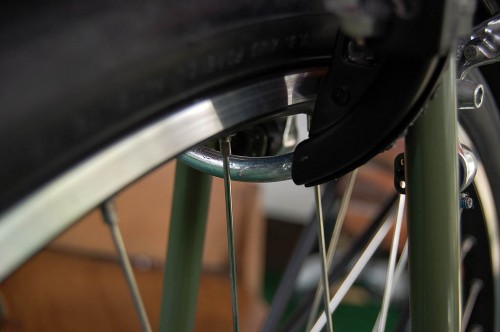 I may give it another go, but I don’t know if it’s really worth it. The website description says it weighs about 13.5 ounces (385 grams). Even though I’m not overly concerned with weight, I think I could spend those 13.5 ounces better somewhere else.
I may give it another go, but I don’t know if it’s really worth it. The website description says it weighs about 13.5 ounces (385 grams). Even though I’m not overly concerned with weight, I think I could spend those 13.5 ounces better somewhere else.
It might be OK for a commuter bike, but I wouldn’t put it on a tourer.
I’ll send a link to this page to the Velo Orange folks who will probably tell me exactly how I SHOULD have put in on in about three minutes time. If they do, I’ll publish detailed pictures to save someone else my hassles.

Even with your photos, I’m struggling to figure out how this thing works. Does it lock over the tire/wheel AND the frame of the bike? Or is it the bike equivalent of the “boot” cops put on your car that immobilizes one wheel?
Either way, I doubt if I’d use it, even “just for a few minutes.” If it isn’t locked to a structure, what’s to keep someone from tossing the bike in the back of their car or truck?
George,
It attaches to the bike. When you lock it, a steel ring comes down between the spokes so that it can’t be ridden away. The only difference between it and a chain through the spokes is that the ring lock is there all the time. In theory, all you have to do is turn the key, push down the locking lever, take the key out and you’re done.
Yes, you’re right. It won’t do anything to protect it against someone who has the ability to carry it off. It DOES slow down the jump-and-ride casual thief.
Credit where credit’s due. I sent an email to Velo Orange last night and got a quick reply from Tom this morning:
Hi Ken:
The ‘zip tie’ should have both ends threaded through the slots of the ring lock, forming a loop that captures the seat stays.The block where the screw is (and where the end of the plastic leader feeds into) should nest inside the ringlock. There will be tight clearance between the tire and the lock but there is enough for safe passage. I will try to follow up with some photos later today.
I say ‘later today’ because Chris and Annette are on vacation until Tuesday August 4th and I am the only one answering 8 inboxes, 4 phone lines, maintaining 2 blogs, and the facebook and twitter feeds, in addition to the retail and wholesale stores backends.
The ring lock may not work on every bike out there, but it should fit on a LHT without too much trouble. Some customers have replaced the plastic zip tie thingys with stainless hose clamps- that may give you more clearance too.
I replied:
Sounds like you have plenty of fish to fry without bothering with me.
If I’m reading you (and some others who replied to me) correctly, the plastic tie will start and end inside the opening on the lock. No part of it will go around the outside of the lock.
To put it in old Boy Scout bowline tying terms, the rabbit jumps into the hole, walks around the tree and jumps back out of the hole.
Will the block with the screw be on the tire side or the outside or does it make a difference?
I’ll wait until I have the bike up on the workstand again and give it another try.
Thanks for the tip. No hurry to get back with me.
Minutes later, Tom answered:
Yes- the boyscout bowline method is what I was trying to describe.
The block should be on the tire side. But- whatever works will be the best solution- sometimes not the most elegant method, but it gets the job done. For inspiration:
Sorry you had trouble, Ken. I thought it was easy to put on. Just heavy and not much security. You have the bowline backwards, too. OUT of the hole, around the tree, DOWN the hole. See, he lives IN the hole, that’s where…oh, never mind. Just trying to help out…
Steve,
I KNEW some Boy Scout would pick apart my analogy. I’ve tied many bowlines using that technique, but it didn’t scale well to the ring lock.
Of course, you’re assuming that I was referring to a hole in the ground in my example.
So, do you have one of these animals? (The lock, not the rabbit.) And was it really as simple to put on as I’m afraid it is or are you just assuming, like I did, that it’s easy?
No rabbits were harmed in the making of this example, by the way.
the reason they are popular in Europe (actually I think just the Netherlands) is because everyone rides a bike and not many people drive pickup trucks.
You’re just trying to keep people from riding off with your bike, and not much risk of it being carried away. Also (from a friend who’s been there a few times) all the bikes are either crappy or a little less crappy than the next guy’s.
It’s easy to see where you went wrong in your installation and previous replies have pointed out the correct way to attach the lock to the bike. If you’ve buggered up the supplied attachment mechanism couldn’t you use a couple of large nylon cable ties on each side of the lock instead? They’d also probably be easier to manipulate in tight quarters and maybe give you more clearance between the tire and the lock.
I ride mostly in the country and small towns, so I liked the idea of the ring lock to stop casual theft. But on my LHT, the brake pads extend beyond the front of the seat stays, so the lock installed flush against the seat stays would interfere with my braking. I probably could have bought shorter brake pads to obviate that problem, but the other drawbacks of the lock made additional investment unwise.
Looks like a good secure lock, might get this for my son when he leaves his bike at school, not the most secure place, quite a few chancers.
This is link spam, by the way.
I’m revisiting this old post because I saw a variation on this lock while touring in the Netherlands recently. A common version there has the ring lock fixed to the bike, but there’s a slot opposite the key for a cable. The cable has a loop at one end and a peg that fits into the slot on the other. You put the cable around a fixed object and thread the peg through the loop, then put the peg into the lock, turn the key, press the ring lock in place, take they key and go. Now the wheel can’t turn and the bike is locked to something else. It’s not as secure as a U-lock but it is much more convenient.
In the small towns where I was touring (Amersfoort was the largest), most people used the ring lock by itself during the day, but if they left their bike outside overnight, they tended to use a chain or a U-lock.
For those who think the locks are just for minor protection and that bikes are all beaters in the Netherlands, I would not call my 4,500 Euro custom scott a beater. It was built for me by Kaptein Tweeweilers in Amsterdam, and, like my 3500 Euro French road bike before it (which I also still have) was used as a daily commnuter 11 miles each way to and from work plus 10-15 miles per day to clients andmeetings for 4 years before being retired to the much less grueling weekend rides in the U.S. (only macho men and texting women in huge trucks and SUVs weaving all over the road instead of Tram tracks waiting to catch the wheels of the unwary rider and cars, trucks, scooter riders, other bike riders, and pedestrians trying to squeeze that extra few inches around each other on narrow European streets).
Of course, I always used both the read keylock and an ABUS chain lock through the frame and front wheel as well.
Practices which I continue to use in the States now that I am back home as well.
The point being, don’t think that every bike that looksbad in the Netherlands is a beater. Many riders, like I did while there, commute anywhere from 5-25 miles to work and back home on their bikes every day. For those who commute, again like myself, they do not buy cheap bikes. In fact, bike commuters and just the ride to the train station riders, nomrally have several bikes. One beater for each end of the home-to-train-station-to-work and back rides plus a primary bike for the serious rides. For the serious commuters (about 35-30% of the riders), they also have two-three road bikes that equal anything most of the day-trip road bikers in the U.S. use.
On average, most Dutch people spend anywhere from 1000-5000 Euros ($1500-$7500) on their primary bike plus 500-750 Euros per year on parts and supplies keeping them up.
For the serious commuters, the expenditures often double. In my case, at 40-50 miles per day, 5 days per week plus 60-100 miles goofing off on the weekends, I had to have one of my three bikes rebuilt every two months or so. My Beca (an Indensian bike-taxi) which I used to taxi my wife and daughter aroung Amsterdam on weekends (year round) had to have new gears, bearings, chain, and tires every 5-6 months or so.
My total expenses as a bike commuter averaged about 200 euros per month.
The point being, never judge a book by its cover, and don’t ever think that a vacation or short visit to the Netherlands will teach you all about the culture.
As for the rear wheel ring locks, they are great. I just ordered six for installing on family bikes in the states.
Dr James E. Atkinson, US Navy (ret)
Locks like this are overly complicated in my opinion, a simple coiling cable lock does the job just as well.
It’s called an Abus, not an Arbus :-).